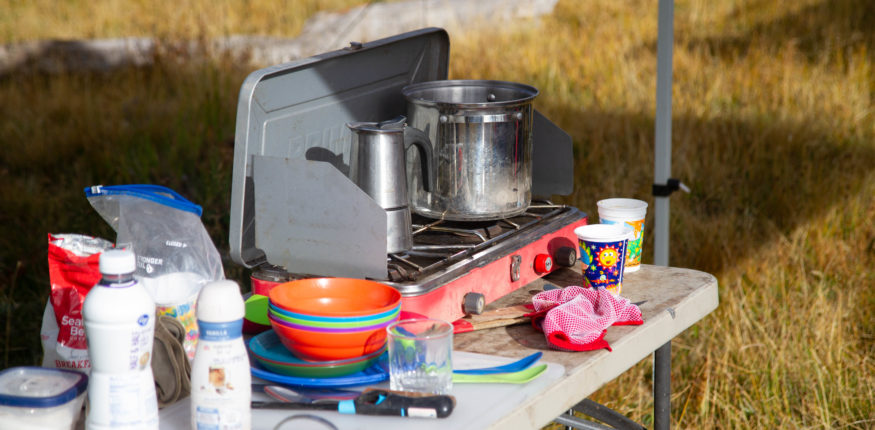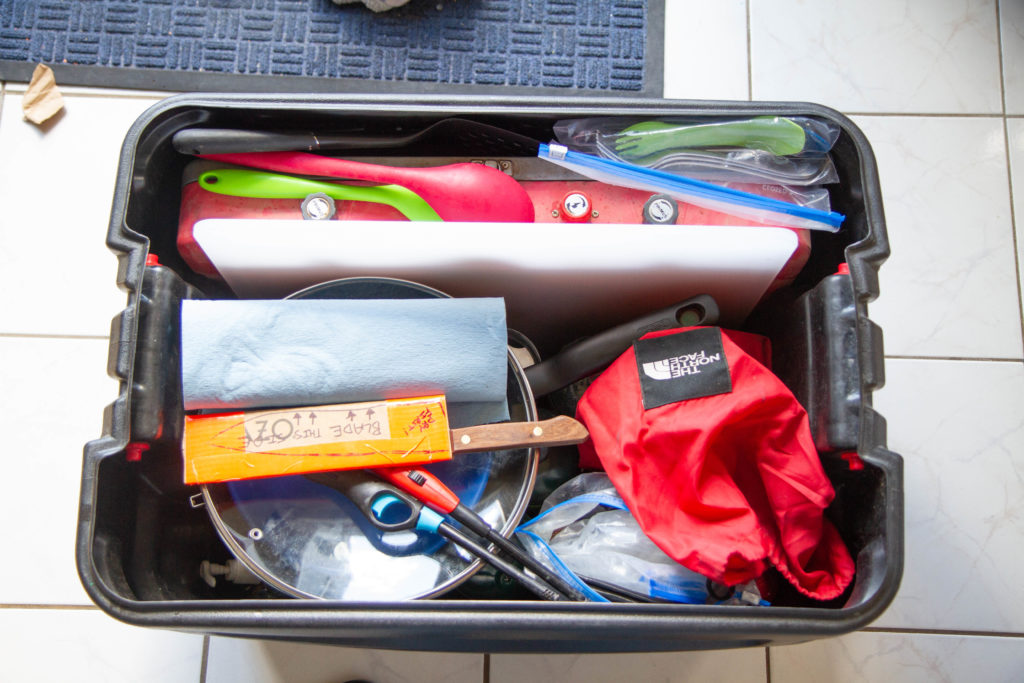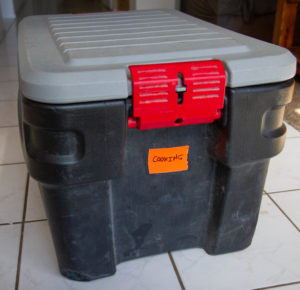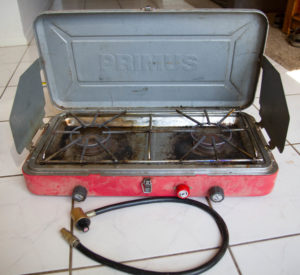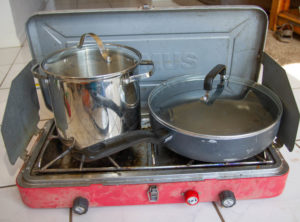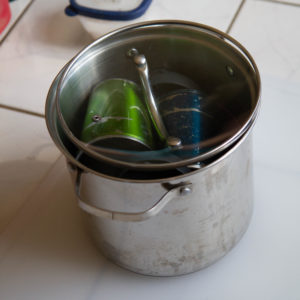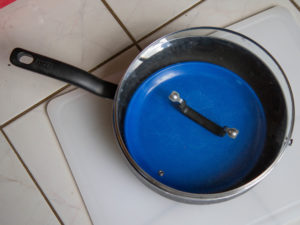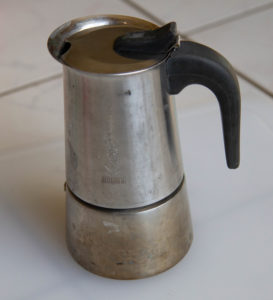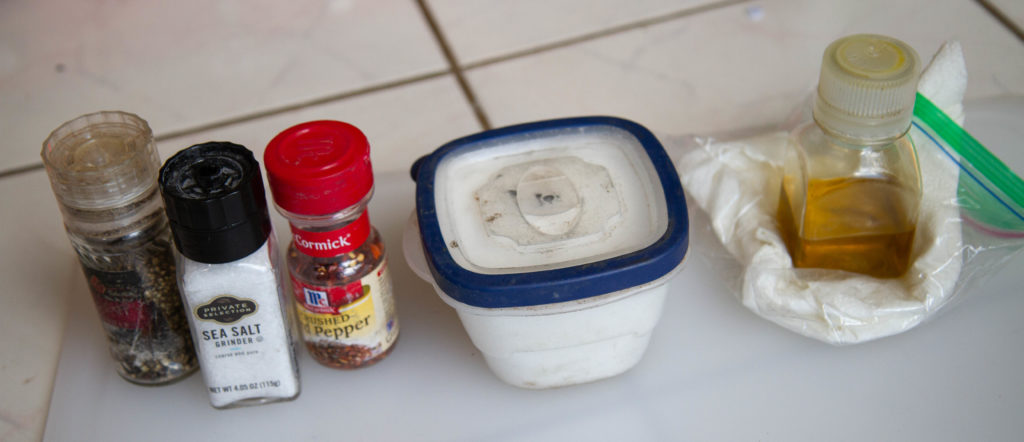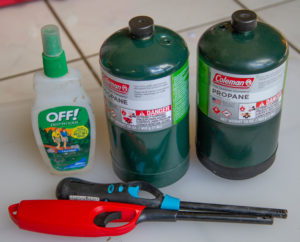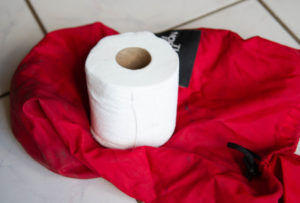Everyone’s least favorite part of camping is packing all your gear.
Matt has calculated that, no matter how much time we spend packing the night before a camping trip, it still takes us at least 3 hours to leave the house in the morning. And, almost always – though, in my defense, I have gotten WAAAAYYY better at this – we have to stop at the grocery store on the way out of town because we are missing some key meal ingredients. One of the things that takes up the least amount of time to pack is our cooking bin.
The Cooking Bin – a complete kitchen for car-camping
The cooking bin holds everything we need for food except the food itself. The secret is that this bin is pretty much complete at all times. Occasionally we double-check to make sure that we really DID put back the knife or the coffee pot after last time, but for the most part, the bin is all ready to go. We intentionally purchased or re-purposed silverware, plates, bowls, mugs, spices, pans, pots, specifically for camping. When we get home from a trip, we immediately take the cooking bin into the kitchen, unload everything into the dishwasher, clean the cutting board and other non-washer-friendly items, then re-pack it all so it’s set for next time. Having this cooking bin has simplified packing SO MUCH. We never worry if we’ve forgotten the camp stove, or propane, or salt and pepper…. it is all there and if we need to replace something, we discover it while unloading after the trip or we make a note of it and replace it ASAP
ONE bin to rule them all…
We see a lot of people carrying around multiple bins for cooking – they have their silverware and dishes in one bin, their spices in another… and you gotta do what you gotta do! (And, most importantly, it all has to fit in your car!) For us, we’ve found that it works best to have one single bin that holds everything we need.
Below is a list, with links, of everything that we keep in our cooking bin. Though they are large, we use Action Packers for storing nearly all the rest of our other gear, too, as Matt insists that everything be bin-able if possible. (For what it’s worth, the Action Packers justify their size and price by being waterproof, very durable, easy to clean, doubling as seats or tables, and fairly lightweight.)
OUR COOKING BIN ESSENTIALS
Propane Camping Stove – we ended up with a Primus for a couple of reasons, not the least of which was because it was the only one with burners our coffee pot could solidly rest on, and it fits inside of an Action Packer. We also wanted to have a stove that would hold a decent size pan & pot next to each other at the same time. This stove has been good to us so far. Like most camp stoves, the automatic lighting feature quit on us fairly quickly, but aside from that, it’s been great.
Cutting Board – hard, durable, plastic board that is less likely to slip, won’t blow away like the thin mats, and is easy to clean.
Silverware for adults and kids – these days we just store ours in a ziplock gallon bag, but we’re planning to get a washable draw-string or roll-out bag like this instead
Can opener – Matt thought our regular-size can opener was taking up too much space, so he went the opposite direction with this insanely small one which is actually pretty easy to use.
Cooking utensils – slotted spatula, silicone spoon & spatula, chef’s knife w/improvised DIY cardboard sheath
Paper towels – we carried regular paper towels around for years until we discovered that these blue shop towels are more durable, longer-lasting, and multi-purpose.
Pot w/lid – I don’t think the one in the link is our exact one, but it’s close. Ours is approx5-6qts. Just make sure whichever one you get fits easily on your campstove.
Kids plates – we also used these divided ones when the kids were younger
Bowls – these bowls, though thin and light, have held up surprisingly well. They are large enough to accommodate adult-size servings and are very easy to clean.
(not pictured – adult plates)
Stainless steel mugs w/plastic sipper lids – I couldn’t find a link to these exact mugs, but – to be honest – I don’t love ours. However, they do offer the necessary features of a good camp mug: easy to clean, keeps drinks hot/cold, holds a sufficient amount of coffee, and, most important, fits in your camping chair cup-holder (i.e. no/folding handle)!
- If you’re really tricky, you can get the plates, the bowls, and maybe even the mugs to fit in your pot!
Pan w/lid – again, make sure it’s big enough for what you want to cook (fish? stirfry? slew of eggs?), and can fit on the camp stove with your pot. We removed the hand-grip opposite the handle, in order to make ours fit and take up less space in the bin. We tuck our adult plates inside the pan for storing in the bin.
Stovetop espresso maker – we use it to brew standard coffee. This design got us through a year on the boat and has been good to us camping. It can take a while if you’re trying to make multiple cups of coffee for a group, but aside from that, it’s relatively fast for a single cup, easy to clean, and compact.
Tupperware of sugar, salt & pepper, red pepper flakes, small container of olive oil.
OFF – for bugs
Propane cannisters (always take an extra one!)
Dishsoap & sponge
Washcloth for drying
Trashbags
** I will usually take a gallon-size ziplock with several smaller ziplocks inside for storing lunches for hikes, etc. I generally also take an extra tupperware for dinner leftovers.
Unrelated to cooking, but also essential…
Paracord and extra tent stakes
Sunblock
Toilet paper, small trowel & travel-size hand sanitizer in a stuff sac – Now that I think about it, is it gross that we keep the poop bag with the cooking stuff? Ha! Good thing the poop bag only holds those items needed for a successful poop experience... We keep it in the cooking bin to make sure we DON’T FORGET IT.
